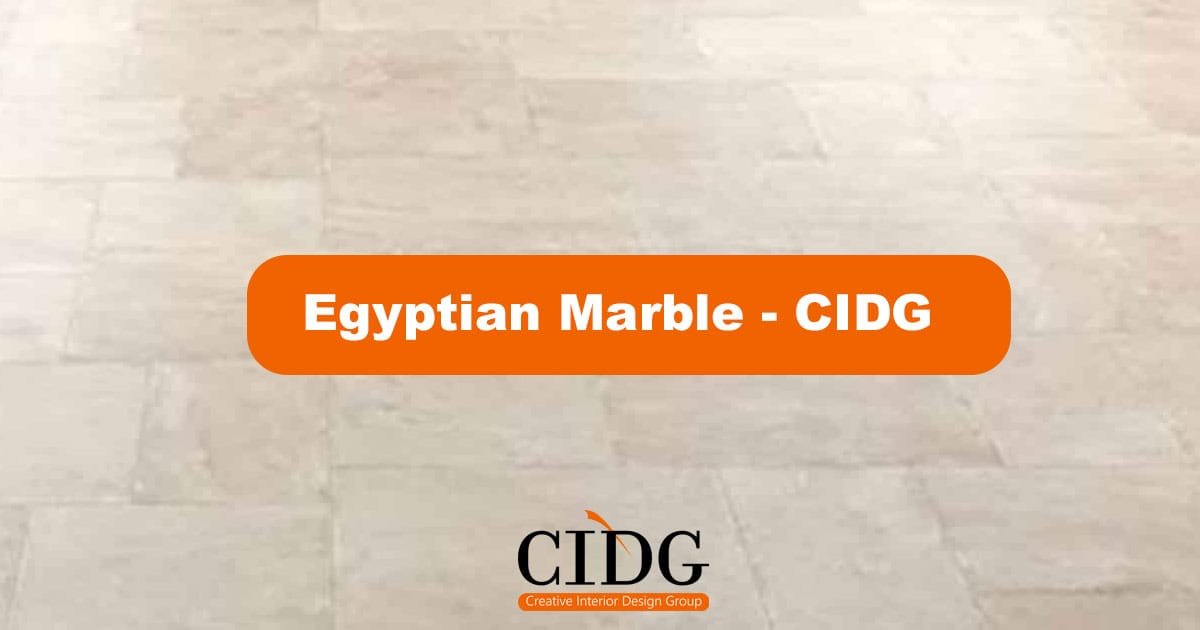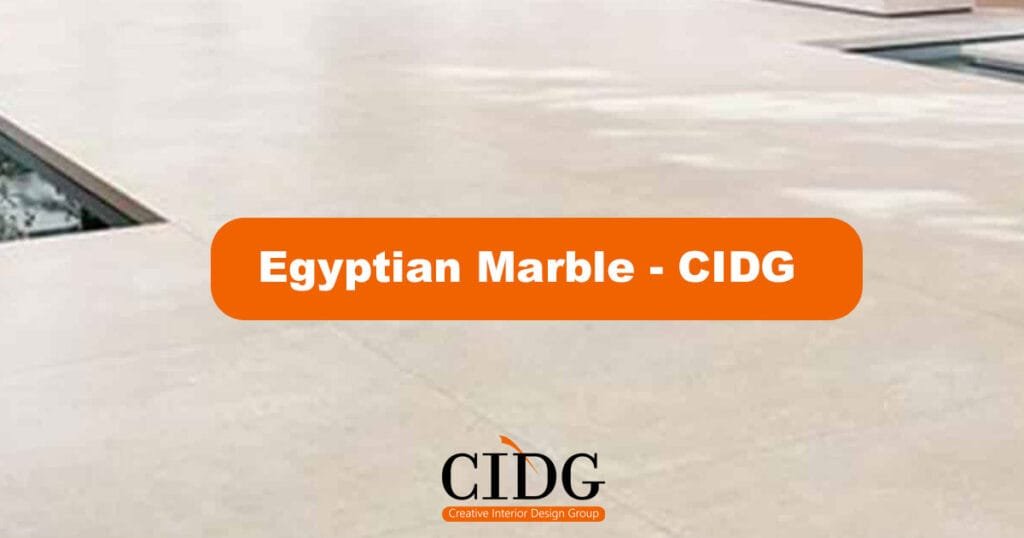Marble has been admired for centuries for its timeless beauty, smooth texture, and luxurious appeal. Among the world’s finest sources, Egyptian marble stands out for its rich colors, natural diversity, and enduring quality. From ancient temples and palaces to modern hotels and villas, Egyptian marble has continued to inspire architects, designers, and builders worldwide.
In this article, we’ll explore what makes Egyptian marble globally recognized, the main types that define its legacy — Galala, Triesta, Sunny, and Silvia — along with its extraction process, and how CIDG Egypt ensures the highest international quality standards. We’ll also uncover the fascinating journey of marble from ancient Egypt to contemporary design.
The Enduring Legacy of Egyptian Marble
Egypt has been a global hub for stone craftsmanship for over 5,000 years. From the majestic pyramids to the temples of Luxor and Karnak, marble and limestone played a vital role in defining ancient Egyptian architecture. The stone was not only a building material but also a symbol of power, purity, and eternity.
In modern times, Egyptian marble continues this tradition — adorning luxury hotels, government buildings, and private residences across Europe, Asia, and the Middle East. Its unique textures, color variations, and high durability make it a favorite choice among designers seeking a blend of heritage and modern sophistication.
Why Egyptian Marble Is Globally Recognized
1. Exceptional Natural Beauty
Egyptian marble is known for its elegant veining, smooth texture, and warm color palette ranging from beige and cream to gold and honey tones. Its subtle patterns add depth and richness to any surface, making it suitable for floors, walls, countertops, and facades.
2. Geological Excellence
Formed over millions of years from sedimentary limestone deposits, Egyptian marble has a fine crystalline structure that gives it both strength and translucence. This makes it ideal for both interior design and architectural applications.
3. Wide Range of Varieties
Egypt offers an impressive selection of marble types, each with distinct characteristics. From the creamy tones of Galala Marble to the golden warmth of Sunny Marble, every type carries a unique aesthetic signature that appeals to diverse design preferences worldwide.
4. Cost-Effectiveness and Quality
Compared to Italian or Turkish marble, Egyptian marble offers a competitive price point without compromising on quality. The proximity to international shipping routes and advanced processing facilities make Egypt a reliable exporter to Europe, the Gulf, and North America.
The Main Types of Egyptian Marble
1. Galala Marble: The Classic Egyptian Masterpiece
Galala Marble is perhaps the most famous Egyptian marble, recognized for its creamy beige tones and subtle veining that exude elegance and warmth. Quarried from the Galala mountain range near Suez, this marble has been a favorite choice for both traditional and modern designs.
Its neutral color makes it ideal for a wide range of applications, from flooring and wall cladding to bathroom surfaces and hotel interiors. Galala marble’s soft hue enhances light reflection, creating bright, open spaces that feel natural and luxurious at the same time.
2. Triesta Marble: The Warm, Earthy Elegance
Triesta Marble, also known as “Jerusalem Beige,” features a blend of beige and light brown shades that add warmth and sophistication to any setting. Its natural charm and homogenous texture make it one of the most versatile types of Egyptian marble.
Triesta marble is widely used in residential and commercial projects, particularly for flooring, staircases, and wall coverings. Its durability and resistance to wear make it suitable for high-traffic areas while maintaining a refined, natural look.
When polished, it radiates a soft sheen that enhances its earthy tones — making it a favorite among designers who seek both beauty and practicality.
3. Sunny Marble: Radiance from Nature
Sunny Marble is aptly named for its golden beige hues and natural warmth. Quarried in the Sinai and Galala regions, this marble reflects the sunlight in a way that brings brightness and comfort to interiors.
Its unique charm lies in the variety of shades, from light cream to honey gold, making it suitable for both contemporary and traditional designs. Sunny Marble is commonly used for flooring, countertops, wall cladding, and decorative columns.
When combined with darker stones like granite, Sunny Marble creates a striking contrast that highlights the sophistication of natural materials in modern architecture.
4. Silvia Marble: The Stone of Subtle Luxury
Silvia Marble is characterized by its fine linear veins and soft beige or light brown tones, giving it a sleek and elegant appearance. It’s especially valued for its uniform texture, which provides a clean and consistent look across large surfaces.
Silvia marble’s versatility makes it a preferred choice for interior flooring, wall panels, columns, and facades. It’s often used in luxury residential and commercial projects due to its ability to create an understated yet refined atmosphere.
Designers often pair Silvia Marble with Granite from Egypt to achieve balance between texture and tone, combining the softness of marble with the resilience of granite.
Marble’s Role in Architecture: From Ancient Egypt to Modern Design
Marble has played a central role in Egyptian architecture for millennia. Ancient Egyptians used stone extensively in temples, tombs, and monuments, symbolizing strength, purity, and immortality. The use of marble-like limestone in the Pyramids of Giza, for example, reflected not only technical mastery but also a deep appreciation for natural beauty.
In modern times, Egyptian marble continues to embody these values. Architects around the world use it to bring a sense of continuity between past and present. Whether in luxury hotels in Dubai, villas in Italy, or public spaces in Cairo, Egyptian marble connects contemporary design with the country’s artistic heritage.
Its natural elegance, versatility, and historical significance make it a preferred choice for high-end interiors, flooring, wall coverings, and even sculpture — just as it did thousands of years ago.

The Extraction and Processing of Egyptian Marble
The journey of Egyptian marble from quarry to installation involves precision, expertise, and innovation. The process ensures that every slab retains its natural beauty while meeting international standards of durability and consistency.
1. Quarrying
Marble extraction begins in Egypt’s Sinai, Galala, and Suez regions, where skilled quarry workers cut large marble blocks from the mountains using advanced diamond wire saws and controlled blasting techniques. This ensures minimal waste and maximum preservation of the stone’s natural texture.
2. Block Transportation and Selection
After extraction, the blocks are carefully transported to processing facilities. Each block is inspected for color, pattern uniformity, and structural integrity. Only the finest selections proceed to the next stage.
3. Cutting and Shaping
Modern machinery slices the marble into slabs or tiles of varying thicknesses, depending on the client’s specifications. Precision cutting ensures perfect edges and consistent sizing for easy installation.
4. Surface Finishing
Depending on the project’s aesthetic requirements, marble can be finished in several ways:
Polished: for a glossy, reflective surface.
Honed: for a smooth, matte appearance.
Brushed or Tumbled: for rustic or antique finishes.
Each finish enhances the natural veining and color of the marble, giving it distinct character and texture.
5. Quality Control and Export
Before export, every slab undergoes a thorough inspection to ensure it meets international quality standards in terms of finish, thickness, and appearance. The slabs are then securely packed for global shipping.
CIDG Egypt: Ensuring World-Class Marble Quality
CIDG Egypt (Cairo for Import, Development & General Construction) has earned its reputation as one of the most trusted suppliers and exporters of Egyptian marble and granite worldwide.
Here’s how CIDG ensures quality from quarry to installation:
1. Direct Quarry Sourcing
CIDG operates in close partnership with local quarries, ensuring complete control over material selection. This direct sourcing eliminates intermediaries, guaranteeing authentic, high-grade Egyptian marble at competitive prices.
2. Advanced Processing Facilities
The company’s factories in Cairo and the Galala region are equipped with state-of-the-art cutting, polishing, and finishing machines, ensuring precision and consistency across every slab and tile.
3. International Standards of Quality Control
Each product undergoes multiple quality checks at every production stage, from raw block inspection to final packaging. This guarantees that CIDG marble meets ISO-certified global export standards.
4. Customization and Finishing Options
CIDG provides a range of customized finishes and dimensions tailored to meet specific architectural requirements — from polished interiors to honed or tumbled outdoor surfaces.
5. Sustainable and Ethical Practices
CIDG prioritizes environmental responsibility, using eco-friendly quarrying methods, recycling water during processing, and minimizing waste. This commitment ensures that the company’s products are both ethically sourced and environmentally sustainable.
Global Demand for Egyptian Marble
Egyptian marble enjoys strong demand in markets such as Italy, Greece, Saudi Arabia, UAE, China, and the USA. Its natural warmth, consistent quality, and affordable pricing make it a top contender in global construction and interior design.
As the world moves toward sustainable and natural building materials, Egyptian marble continues to shine — valued for its long lifespan, timeless appeal, and minimal maintenance requirements.
Whether for luxury villas, commercial complexes, or public landmarks, Egyptian marble brings elegance, tradition, and durability to every project.
Frequently Asked Questions
1. What makes Egyptian marble different from other marble types?
Egyptian marble is unique for its warm beige tones, fine texture, and versatility. Its natural formation gives it a softer, more organic appearance than many European marbles, making it ideal for both classical and modern designs.
2. Is Egyptian marble suitable for outdoor applications?
Yes. Many types, including Galala and Sunny Marble, perform well outdoors when properly sealed. Their durability and weather resistance make them suitable for façades, terraces, and garden pathways.
3. How does CIDG ensure quality during export?
CIDG implements a strict quality assurance process at every stage — from quarry selection to final inspection. Each shipment is certified for dimensional accuracy, color consistency, and surface finish before export.
4. Which finish is best for marble flooring?
A polished finish provides a luxurious shine for interiors, while a honed or tumbled finish is recommended for outdoor and high-traffic areas due to its non-slip surface.
5. Can marble be combined with other stones?
Absolutely. Designers often combine Egyptian marble with Granite from Egypt to create stunning visual contrasts that balance elegance with strength.
6. How to order?
To place an order or request a quote for any of our products, simply contact our sales team through one of the following options:
📞 Mobile: +20 100 164 9770
💬 WhatsApp: Click here to chat directly
✉️ Email: Marketing@cidegypt.com
Our team at CIDG Egypt will guide you through the product selection, customization options, and shipping details to ensure a smooth and professional ordering experience.

